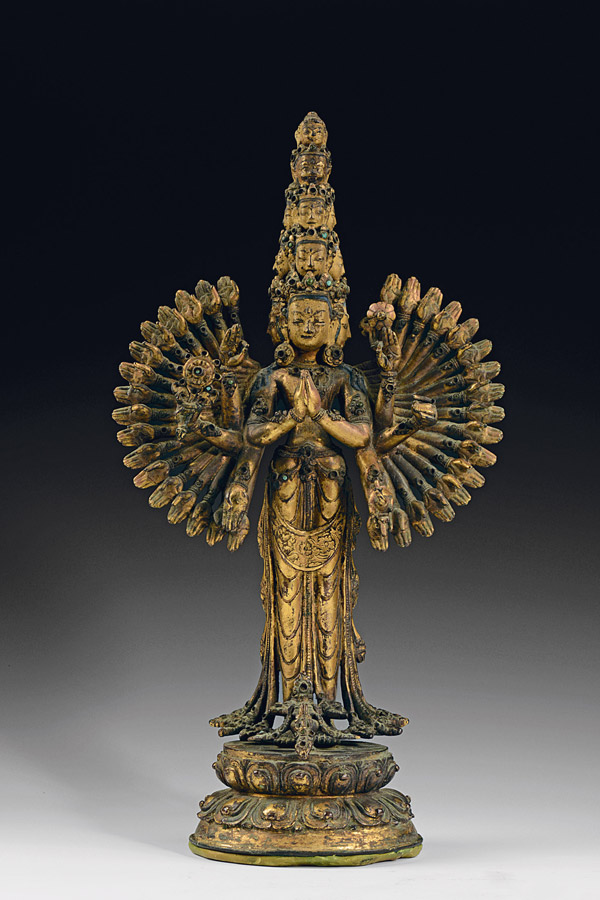Pratapaditya Pal: Roshan Sabavala’s Tryst with Himalayan Art
- click on the image to enlarge | click on the Expand icon upper left to enlarge further
click Esc to close and return to this page
Lot 42: Eleven-Headed Avalokiteshvara
Gilt-bronze with applied pigment, inlaid with semi-precious stones
Tibet
15th or 16th Century
Height 12 in. (30.5 cm.)
The eleven-headed, eight-armed deity standing atop a circular double-lotus base, his primary hands folded in front of his chest in anjalimudra and his secondary arms around him, one in vitarkamudra, one in varadamudra, the others holding a lotus, a water vessel, and a dharmachakra, surrounded by his multiple arms radiating around him in a fan-shaped arc. The delicate elongated torso and long legs clad in a dhoti that moulds to the legs with several incised inverted u-shaped folds all the way down towards the ankles, secured with a pendant belt once inset with hardstones, several sashes billow out from the waist, and adorned with necklaces and other jewellery once inset with hardstones. The faces finely detailed with remains of polychrome surmounted by elaborate crowns once inset with hardstones, the tenth head in a fierce expression, his snarling mouth open to reveal fangs, the highest head that of Amitabha Buddha, the base with an overflowing vase of jewels, representing the three jewels of Buddhism.
According to the Mahayana doctrine, Avalokiteshvara made a great vow to listen to the prayers of all sentient beings in times of difficulty and to postpone his own Buddhahood until he had assisted every being on earth in achieving nirvana.
Befitting his mission, he is an embodiment of grace and compassion, a classic image of a bodhisattva. After working diligently at this task for a very long time, he looked out and realised the immense number of miserable beings yet to be saved. He became despondent and his head split into a thousand pieces. Amitabha Buddha put the pieces back together as a body with a thousand arms, an eye on each palm to see the suffering in the world and eleven heads, the top of which is Amitabha, allowing Avalokiteshvara to assist the myriad of sentient beings all at the same time.
One of the most evocative of all Tibetan Buddhist imagery is this Ekadashamukha manifestation of Avalokiteshvara.The complex sculpture is done in the mature Tibetan style of the 15th century, an assimilation of Indian, Nepalese and Chinese traditions that is now entirely Tibetan in nature, characterised by gilt-bronze with finely chased decoration and predominantly turquoise jewellery. The iconography of the bodhisattva Ekadashamukha Avalokiteshvara has its origins in eastern Indian traditions, and bronze examples exist from the Pala period, see Ulrich von Schroeder, Buddhist Sculptures in Tibet, Hong Kong, 2001, Vol. I, p. 238, pl. 72A. Remarkably however, in this survey of Tibetan monastery collections von Schroeder does not record a single example of the popular iconography in this 15th century style of gilt-bronze, highlighting the rarity of the sculpture. A smaller, slightly earlier example, however, is kept in the Tibet Museum, Lhasa, see Kulturstiftung Ruhr Essen, Tibet: Klöster öffnen ihre Schatzkammerern, 2006, p. 255, Kat. 33. And a much later 18th century example is now in the Norbulinka, Lhasa, ibid, p. 260, Kat. 34. Compare a larger 15th century gilt-bronze example, formerly in the Philip Goldman Collection, see Ulrich von Schroeder, Indo-Tibetan Bronzes, Hong Kong, 1981, p. 453, pl. 124D.
